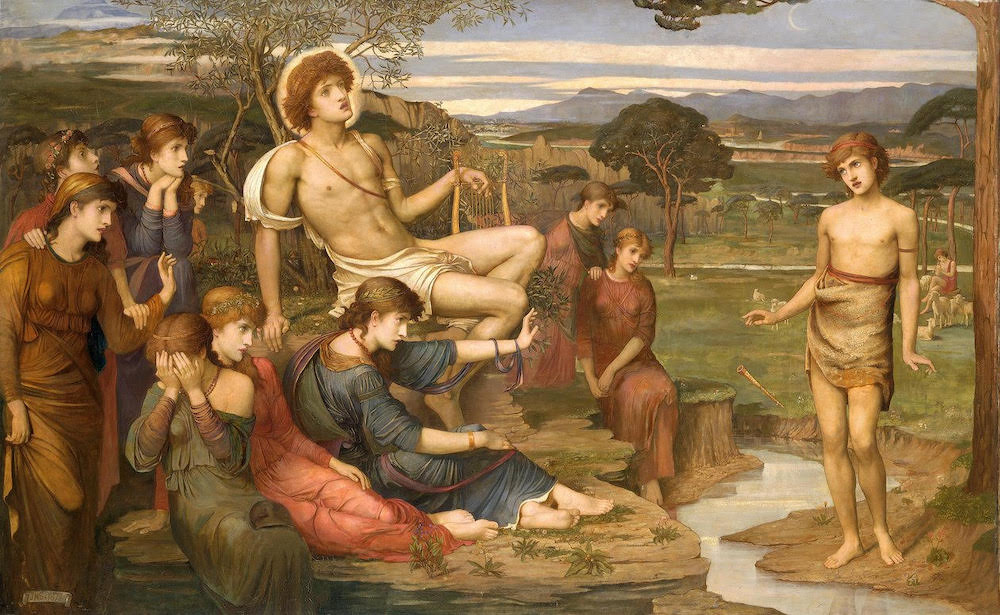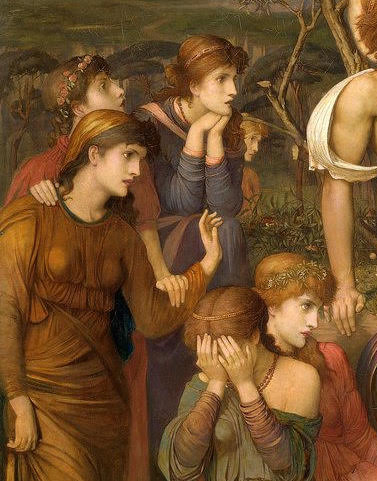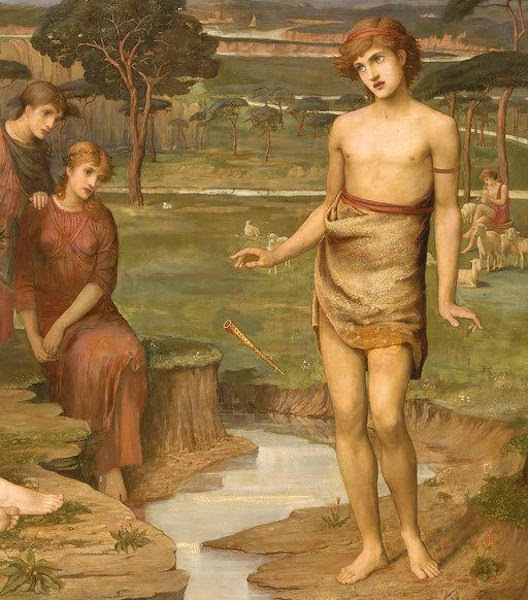
Apollo and Marsyas Click on all the images on this page to enlarge them. Clicking on this first image, of the whole painting, will also take you back to the first part of the discussion.
Strudwick exhibited Apollo and Marsyas at the Grosvenor Gallery in 1880, no. 50. It is another of his works dealing with the theme of music, but the first of them to feature a story taken from Greek mythology. This subject was not uncommon in the work of the Old Masters, with paintings by artists such as Raphael, Titian, Tintoretto, Bronzino, Giordano, and Ribera. It was a very uncommon subject in Victorian art, however, although Henry Wallis exhibited Marsyas at the Royal Academy in 1869, no. 442, one of that artist's rare forays into classicism. Wallis's painting showed a later episode in the story where Apollo is shown reclining in a shady glade, while further away in the shadows nymphs can be seen lamenting over the fate of the presumptuous Satyr, who is seen in the distance strung up for flaying.


Left: The various expressions of Strudwick's Muses. Right: The vulnerable Marsyas, not at all satyr-like in Strudwick's version, as the flute falls from his hand.
Contemporary Reviews of the Painting
The critic of The Academy contrasted the work of Social Realist painters like Alphonse Legros and Jules Bastien-Lepage to those of the followers of Edward Burne-Jones:
A different and swifter fate is, we fear, in store for the opposite extreme of art, as represented in the Grosvenor by the clever pictures of Mr. Stanhope and Mr. Strudwick. It is distinguished by its desire for beauty and its hatred of facts, but its search for the former is not so successful as its avoidance of the latter. In order to escape with certainty any too near approach to realism Mr. Stanhope does not trust to his own powers of conventionalising nature, but frankly adopts the manner of certain early Italian artists whose earnest desire to paint what they saw was thwarted by want of knowledge and skill. The design of Mr. Stanhope of The Waters of Lethe is distinguished by much that is pretty in form and colour, and that of Mr. Strudwick of Apollo and Marsyas is refined though weak in expression; but both represent to us Art in love with its own beauty, and doomed, like Narcissus, to end in interesting suicide (372).
A reviewer for the Architect felt that in this work Strudwick copied too many of the faults of early Italian Renaissance painters:
Nearby hangs Mr. Strudwick's effort to depict the defeat of Marsyas by Apollo, as described in the Epic of Hades. A noble theme, and fit for pictorial treatment, yet it would have been well for the young painter if he had waited a while before dealing with so high a subject. There is a curious tendency among a certain set of painters to treat landscape details with the perspective exaggeration or untruth which was in the earlier days of art the result not of intention but of ignorance. Landscape truth in any large or poetic sense was not apprehended until the later days of the Venetian school. Therefore when Mr. Strudwick huddles Apollo and the nine Muses together upon a very uncomfortable corner of volcanic rock where there is not room enough for them, and places Marsyas dropping his flute as he listens to Apollo on the other side of a dividing stream in an impossible relation of scale, and then carries the eye out to a pretty Italian landscape regardless of atmospheric effect, he challenges the remark that in these days it would be better to be accurate as well as imaginative, and that this harmoniously coloured and well painted, and we may say poetically thought out, picture would have gained by study of the laws of composition and of perspective a position that it now fails to take. It were indeed well if many of our young painters would digest the truism that affectation is not admirable, nor want of knowledge a path to glory. [318]
Links to Related Material
- Apollo & Marsyas, Part I
- Burne-Jones's Influence upon the Work of John Melhuish Strudwick
- Pamela Gerrish Nunn's "Touching the Strings: Edith Martineau and Aestheticism" (includes a general discussion of the musician figure in later Victorian art)
Bibliography
"The Grosvenor Gallery." The Academy XVII (15 May 1880): 371-72.
"The Grosvenor Gallery." The ArchitectXXIII (8 May 1880): 317-18.
Kolsteren, Steven. "The Pre-Raphaelite Art of John Melhuish Strudwick (1849-1937)." The Journal of Pre-Raphaelite and Aesthetic Studies I: 2 (Fall 1988): 1-16.
Created 25 September 2025